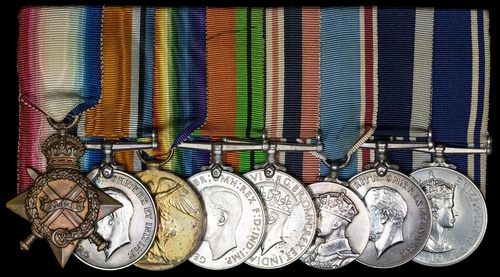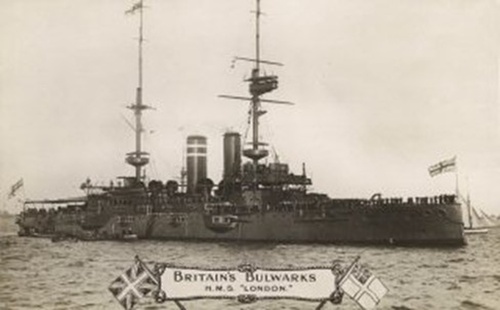Auction: 25111 - Orders, Decorations and Medals - e-Auction
Lot: 462
(x) Eight: Sergeant E. C. Warwick, Royal Marine Artillery later Royal Marine Police
1914-15 Star (R.M.A. 13520 Bugr. E. C. Warwick.); British War and Victory Medals (R.M.A. Gr. E. C.Warwick); Coronation 1937; Defence and War Medals 1939-45; Royal Navy L.S. & G.C., G.V.R. (PLY 21293 E. C. Warwick Cpl. R.M.); Police Exemplary Service, E.II.R. (Sergt. Ernest . C. Warwick), mounted as worn, very fine (8)
Ernest Charles Warwick was born at Portsmouth on 2 December 1898 and enlisted in the Royal Marine Artillery as a Bugler on 5 July 1913. He was serving aboard Shannon at the beginning of the Great War, transferring to London in February 1916 and served aboard her for the remainder of the war.
London was transferred to the 2nd Detached Squadron, organised to reinforce the Italian Navy in the Adriatic Sea when Italy declared war on Austria-Hungary. She was based at Taranto, Italy, and underwent a refit at Gibraltar in October 1915 during her Adriatic service.
In October 1916, London returned to the United Kingdom, paid off at Devonport Dockyard to provide crews for antisubmarine vessels, and was laid up. While inactive, she underwent a refit in 1916-1917. The work included removing her main deck 6-inch guns and the upper deck 12-pounder guns and moving four of the 6-inch weapons to the upper deck battery where the 12-pounder guns had been located.
In February 1918, London moved to Rosyth and began conversion to a minelayer. The conversion included removal of all four of her 12-inch guns and her anti-torpedo nets, replacement of her after main-battery turret with a 6-inch gun, and installation of minelaying equipment on her quarterdeck, including rails for 240 mines, and of a canvas screen to conceal the entire quarterdeck from external view. She also received an experimental dazzle camouflage paint scheme. The conversion was completed in April 1918, and on 18 May 1918 London recommissioned at Rosyth for service in the Grand Fleet's 1st Minelaying Squadron. Before the war ended on 11 November 1918, London had laid 2,640 mines in the Northern Mine Barrage.
Warwick left London in July 1921 and was shore based at Plymouth for the remainder of his service being discharged on 1 December 1937. His Royal Navy Long Service & Good Conduct Medal was issued to him in January 1932. A short spell as a civilian was probably enough to convince Warwick that it wasn't for him and he enlisted in the Royal Marine Police on 4 February 1938.
In the 1939 Register he is recorded as a Constable in the Royal Marine Police living at Gillingham, Kent with his wife and 3 daughters. He died at Gillingham on 17 February 1963; sold together with copied service papers and research.
Subject to 5% tax on Hammer Price in addition to 20% VAT on Buyer’s Premium.
Sold for
£250
Starting price
£110







